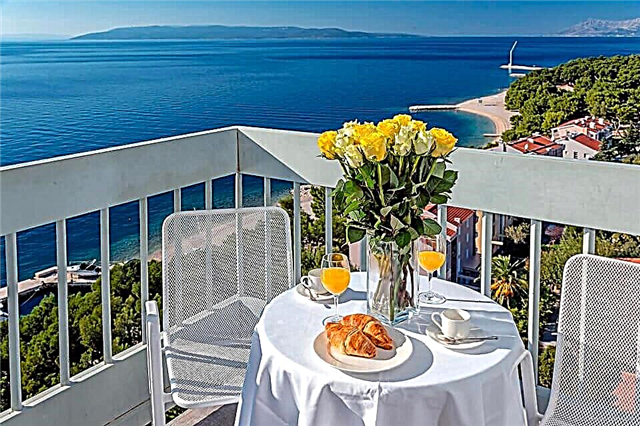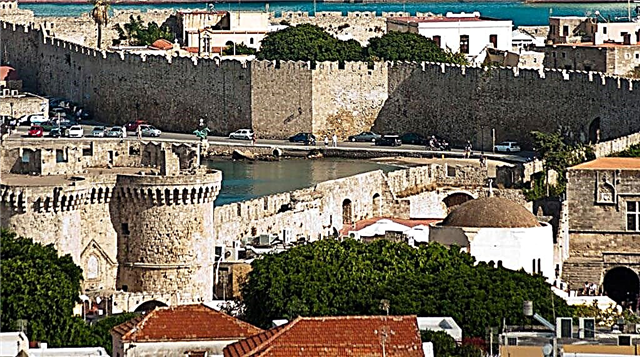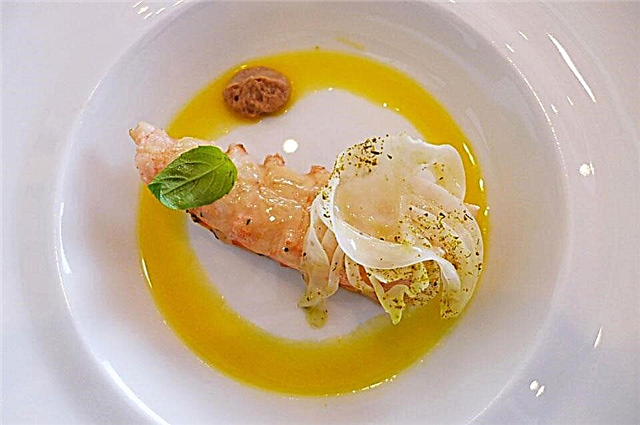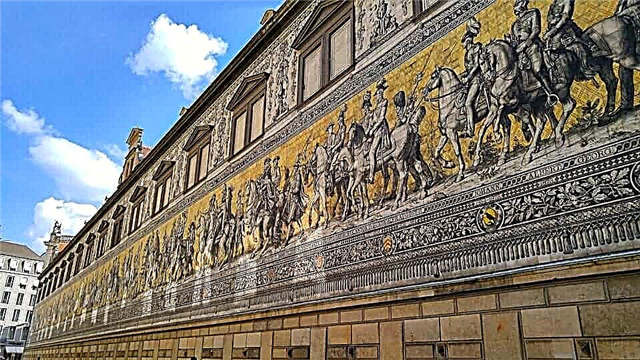Dresden can be safely called a city-monument, a city-museum in terms of the number of architectural monuments and works of art. The first mention of the city, according to documents, was in 1216. The capital of Saxony on the Elbe makes an irresistible impression on everyone who visits it. Destroyed almost to the ground in 1945, Dresden was reborn from ruins like a Phoenix bird and became even more beautiful than it was. Numerous sights of Dresden attract thousands of enthusiastic tourists who have something to see in the museum capital of the world.
Gallery of old masters

The collection of art canvases of the gallery is the national pride of Germany, because it presents masterpieces of painting by the best masters of the world of past eras. The greatest cultural heritage that is kept within the walls of the gallery has been sacredly preserved, despite the devastating impact of the bombing in 1945. All exhibits were carefully restored after being removed from limestone mines, where they were transferred to save them from bombing.
The art gallery has a long history that began at the end of the 17th century, when the Elector of Saxony Frederick the Wise began collecting unique rarities for the Cabinet of Curiosities. At the same time, his court ordered paintings from famous painters Dürer, Cranach and others. Now these recognized masterpieces are priceless exhibits in the gallery. Several generations of electors considered it an honor to replenish the court collection housed in the castle. When the collected valuables, objects of art and paintings could no longer fit in the halls of the castle, under August III they were placed in the restored stables.
Over the decades, the gallery has become the owner of world painting masterpieces, among them Raphael's "Sistine Madonna", many paintings by Rembrandt, Titian, Caravaggio, Velazquez, representing the periods of the Early and Late Renaissance. The pearl of the latter is Correggio's full of tenderness "Holy Night", where the Magi worship the baby Jesus.
Address: Theaterplatz 1
Semper Opera

The magnificent building of the Baroque opera house, located in the center of Teatralnaya Square, is familiar to many. It is the most beautiful opera house in the world, home to the oldest symphony orchestra in the world, organized for over 460 years. The designer of the 3-storey Baroque building was Gottfried Semper (1814), and therefore the majestic building is also called the Semper Opera
By the way, this building is not the first one intended for an opera: the old one burned down during a fire in 1869. The repertoire of the theater includes all the famous classical works of the great composers of the past and productions by contemporary authors, in which the young talents of the opera stage try their hand. Like many cultural sites, the opera has gone through hard times: the building was so badly damaged by the bombing that it took 8 years to restore it.
The best sculptors, restorers and artists selflessly worked on the resurrection of the beautiful appearance of the architectural masterpiece and did it to glory. The stately solemnity of the opera house is given by the magnificent monument to King Johann of Saxony located next to it. Happy is the one who can not only see the Dresden Opera from outside, but also attend one of the performances.
Address: Theaterplatz 2
Dresden Castle Residence

The luxurious architectural complex can only conditionally be called a palace: it consists of several buildings of amazing beauty, interconnected in the Baroque style. In addition to baroque elements in architecture, there is a mixture of other styles, because the palace-residence of the Saxon electors was constantly updated and rebuilt in accordance with new trends in the decoration of buildings.
The configuration of the towers, the gates, the design of the facades changed - and as a result, the most beautiful Dresden castle, the residence of the ruling dynasties of Saxony, arose. Sculptural and stucco decorations, pretentious colonnades, domes create the impression of grace and splendor of the Palace. Each of the buildings of the castle is an example of high architectural art, and the interior design of the interiors is unique and exquisite. Outside, the decorations of the palace can be admired indefinitely: each of them is a kind of work of art.
All buildings of the palace are true architectural masterpieces of the residence. Here is the famous Green Vault Museum with a rich collection of various jewelry. The name of the museum remained as a memory of the past, when the columns in it were painted green (now they are inlaid with mirrors). The Dresden Palace is the main attraction of the Theater Square along with the opera building.
Address: Taschenberg 2
Moritzburg castle

Another gem of Baroque architecture, Moritzburg Castle emerged from a small hunting lodge built in 1564 for the Saxon elite. They stayed there when they hunted ducks. Under Augustus the Strong, a modest hunting lodge turned into a real royal castle, built among lakes literally on the water and connected to the land by a narrow path.
Around the colorful, with bright red roofs and a round corner tower, the castle is surrounded by parks decorated in French and English styles. Inside, the entire interior design is subordinated to the hunting theme: portraits of the goddess of the hunt Athena, the former owners of the castle, plot paintings depicting hunting scenes of gods and titans are placed. There are also portraits of courtesans, placed with a hint of amusement that reigned in the halls and bedrooms of the castle (there are 200 rooms in it) in the old days.
Here you can see magnificent sculptures reflecting the hunting theme; specimens of hunting weapons, hunting trophies and a lot of porcelain. The walls of the rooms are covered with leather wallpaper and silver plates. There is a surprisingly beautiful "Room of Feathers" in the castle, acquired by August for the Dresden Japanese Palace. Its exotic décor boggles the imagination with its amazing accessories.
Pillnitz Castle

The castle, which unites three palaces, is a testament to the luxurious life of the Saxon electors and kings, who sought to capture their wealth and opportunities in architectural structures. Augustus the Strong was especially ambitious, under which significant cultural and historical sites were erected. During his reign (17th century), a complex of magnificent palaces appeared - the summer residence of Augustus.
According to the project of one of the most famous architects Peppelman, the Water Palace was first erected, the main entrance facing the Elbe and connected to the river by an elegant staircase. The author of the project successfully coped with the task set before him by Augustus - to build a palace like no other European country, in the Chinese spirit.
As a result, a structure appeared that embodied the bright beauty, splendor of the Baroque in the design of the facade and the oriental exoticism of the multi-tiered roof-pagoda. A little later, the 2nd palace was built - Nagorny, in many respects repeating the features of the Water Palace in design and color scheme. The buildings are surrounded by a picturesque English-style garden with greenhouses, lawns and fountains. Already at the beginning of the 19th century, the New Palace arose, combining all 3 buildings into one whole and forming a magnificent castle complex - an architectural monument of the past, which arouses great interest among numerous tourists.
Hofkirche
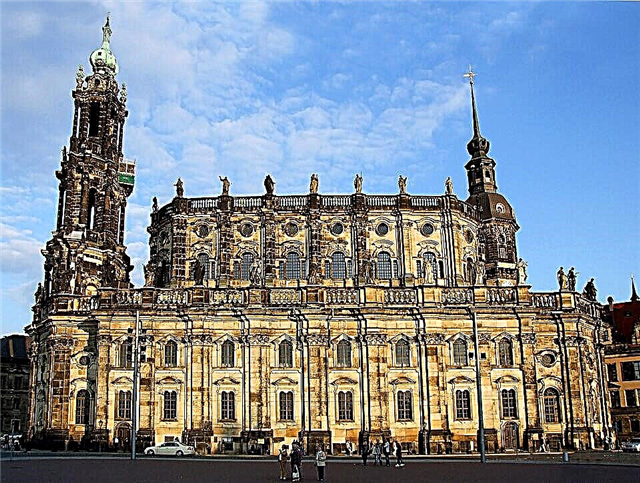
Between the Theater and Palace squares there is a sacred architectural structure - the Hofkirche Cathedral, once the largest church in Saxony.The grandeur and extraordinary external imagery of the cathedral's design make a stunning impression, which is enhanced by a closer acquaintance with the amazing construction, covered with legends.
Here is a capsule with the heart of the most influential Saxon Augustus the Strong, and, as legend has it, the heart begins to beat when beautiful girls pass by the church. In the underground floor of the cathedral there are about fifty sarcophagi with the remains of many rulers of Saxony, including a capsule with the heart of Augustus. Looking at the baroque splendor of the decoration of the cathedral, decorated with 80 sculptures of apostles and saints, it is hard to believe that all this beauty was restored anew from the devastation.
In 1945, the unfortunate bombing destroyed the cathedral almost completely. For two decades, it was collected literally bit by bit and restored to its original form, so that descendants could worship the ashes of those who created the history of Dresden and admire the masterpiece of architecture. A powerful organ is installed in the cathedral, the sound of which surpasses the most famous organs in the world. Organ music concerts with famous performers are regularly held here.
Address: Schloßstraße 24
Military history museum
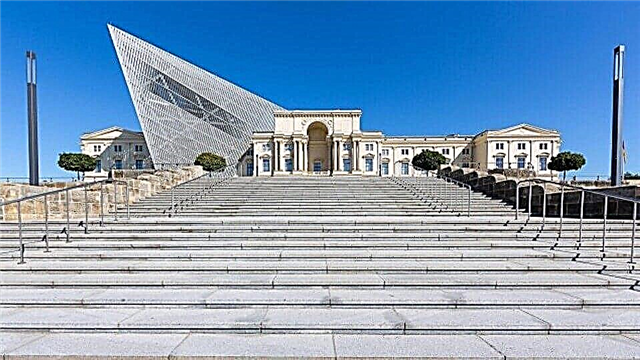
The classic building of the 19th century, in which the military history museum is located, is difficult to miss from the forward-facing glass-metal structure, as if piercing the facade. At first glance, it seems that this is a wedge driven into the wall. But on closer inspection, you can see that the structure is simply lined up against the wall.
The author of this original structure, apparently, wanted to emphasize the fragility of our peaceful life, which can collapse like glass, so the world needs to be protected. Initially, the building was used as an arsenal for the military garrison, then the Royal Museum of the Saxon Army was organized in it (1914). Over the decades, the museum's expositions have collected a huge number of military rarities, various types of weapons and equipment, ranging from medieval to modern ones.
After the defeat of the Nazi troops, all the exhibits of the Bundeswehr were sent to the USSR and returned to Germany in 1972, when the exhibition "Army of the GDR" was organized there. After the unification of Germany, the museum was reorganized, reconstructed, creating interesting exhibitions for visitors of all ages.
Address: Olbrichtpl. 2
Museum "Green Vaults"

If someone, before visiting the Green Vault Museum, thought that he had seen a lot of treasures, then he was mistaken. A huge number of all kinds of items related to treasures are located right here, in the super-rich treasury of the world. The exhibits are striking on the spot with their abundance and sparkling beauty, grace and virtuosity of jewelry craftsmanship. All this wealth is located in the luxurious Dresden Palace, adding its contents to the external grandeur of the palace.
Taking into account the indisputable value of the exhibits, appropriate rules have been developed for visitors, providing for the entrance to the treasury without outer clothing, bags and telephones (they are left in the storage room). The halls display unique items in the form of the Bowl of Ivan the Terrible, mother-of-pearl washstands, outlandish tableware, jewelry, and precious stones. A visit to Green Vaults is a journey through 10 thematic halls.
Each of them has its own masterpieces and unique pieces of the "sapphire" type donated by Peter I; The "green diamond" formed over millions of years; a jewelry masterpiece by the Dingliner brothers - a composition of jewels "The Court of the Great Mogul ..." and many more amazing exhibits. The green diamond is unique, according to mineralogists, there are no similar analogues in the world. At one time, it was acquired for a fabulous sum of 400 thousand thalers (the approximate cost of building the Dresden Cathedral). The exhibits of the Amber Office are impressive, each of which is an artistic masterpiece. Staying within the walls of the Green Vault Museum is the greatest aesthetic pleasure.
Address: Taschenberg 2
Frauenkirche church

The Church of the Virgin, built under Augustus the Strong, is another proof of his merits and important role in the development of Saxony. The magnificent Baroque cathedral served as the city's adornment for two centuries until its brutal destruction in 1945. During the post-war debate about the fate of the remaining ruins, it was decided to leave them as a memory of the horrors of the war. But after the fall of the Berlin Wall, a public movement began in the country on the problem of restoring the Fruenkirche in its original form.
A grandiose work began among the sacred ruins: literally by the remaining stones, by fragments, everything was carefully selected, meticulously numbered and used in the restoration of the temple. The new church - another Phoenix bird - was built of snow-white sandstone and the old building material. Its opening turned into a grandiose celebration that took place in the fall of 2005.
Now, on the walls of the revived church, one can distinguish dark fragments of the former building as a tribute to holy memory, as a part of that era. The Frauenkirche is still the city's main jewel, towering its huge stone dome over the historic city center. Tourists who want to admire the amazing surroundings of the unique city and the picturesque valley of the legendary Elbe ascend to the observation deck of the dome (its height is 68 m).
Address: Neumarkt
Saxon Switzerland

Back in the 18th century, two Swiss artists chose the Elbe Mountains, built of sandstone, as a favorite place for their landscapes. Due to the landscape resemblance to the Swiss Alps, these places were called Saxon Switzerland. The amazing landscapes of these places inspire artists from all over the world. The center of Saxon Switzerland is a 200-meter high virgin rock Bastei (bastion), formed millions of years ago under the influence of erosion.
The extraordinary picturesque nature of the rocks covered with forest made people connect them with a bridge, first wooden, and later stone, which is now used by crowds of travelers arriving by train or sailing along the Elbe by ferry. Back in 1814, 487 steps of the staircase leading upward were knocked out on the rocky slope.
Many people climb along them, eager to find themselves among the wonders of Bastei and see amazing views from the most beautiful observation deck of Saxon Switzerland. A capital bridge was laid between the rocks at a height of 195 meters, which is the result of talented engineering and technology. Erected on the right bank of the Elbe, it allows you to observe lovely rural landscapes, rocks of incredible shapes.
Zwinger

One of the most famous museum centers is located in the heart of the city. The magnificent ensemble is a whole complex of majestic palace buildings. Architect Matthäus Peppelmann worked on the three sides of the complex, giving the building a Saxon Baroque style. Gottfried Semper was the author of the fourth side in the neo-Renaissance style. Now it houses the Dresden Picture Gallery, a magnificent collection of porcelain, a salon dedicated to achievements in physics and mathematics.
The fountains give a special charm to the building, the most beautiful is the "Bath of Nymphs". The eastern pavilion is decorated with a clock equipped with porcelain bells that emit a melodic chime. Unfortunately, the complex was repeatedly damaged as a result of hostilities. After the city was destroyed during the Second World War, the restoration of the Zwinger took a long time and ended only in 1964.
Porcelain Museum

It is well known that porcelain after its appearance began to be called white gold, and the rulers of many countries sought to acquire porcelain, equating them with jewelry.Elector August the Strong, known for his progressiveness, was literally "sick" with porcelain and spent a lot of money on it. Buying Chinese, Japanese and Meissen porcelain, he has amassed a solid collection (35 thousand pieces of various products). The porcelain museum now houses almost 20 thousand exhibits, among which 750 items are real masterpieces of the 12th, 15th, and 18th centuries.
Located in the magnificent building of the Zwinger Palace and is part of the cultural and historical association "State Art Collections of Dresden". Not far from the entrance to the palace, there is an unusual sculptural statue of Augustus. Magnificent interiors are perfectly combined with luxurious exhibits - porcelain sets of all kinds of dishes and individual objects of art: vases, trays, dishes, cups of the most fantastic shapes and types.
The most interesting exhibits are Kirchner's porcelain sculptures. Another sculptor, Kendler, made sculptural decorations for the table, which were in great demand among ordinary people. They are also presented in exhibitions, the public is looking at them with pleasure.
Physics and Mathematics Salon

In the 16th century, a curiosity museum, the Kunstkamera, was founded in the city. Very quickly, the collection accumulated a lot of technical devices and mathematical tools. It was decided to separate this direction into a separate exhibition, the final decision was made by the Elector of Saxony Augustus the Strong. An interesting fact - the collection was a museum, but all the exhibits were available to scientists for research. Later, the complex was supplemented with an observatory.
Nowadays it attracts visitors with many rarities. For example, there is an amazing collection of globes on display here. The oldest dates back to the 13th century. There is a tower clock, created during the Renaissance, many rare optical instruments. An interesting exhibit is a huge fire glass that was used in the production of porcelain. With its help, the required temperature was reached in the furnaces to melt the sand and iron.
Brühl's Terrace

This unique place has another name - "the balcony of Europe". The Brühl Terrace is the Elbe embankment, which lies in the historic center of the old town. It was originally intended to protect the city and became part of the fortifications. This was in the 16th century. Gradually, the terrace was built up with palaces, galleries and gardens. Over time, the military significance was lost.
At the beginning of the 19th century, the embankment, which stretched for half a kilometer, became accessible to the townspeople. It was decorated with a wide front staircase and additional aisles. From the opposite bank of the Elbe River, there is a delightful view of the terrace. It is considered the most characteristic of the city and is recognizable all over the world. The embankment looks especially impressive at night, when the buildings on it are illuminated with delightful illumination.
Panel "Procession of Princes"

This large-scale work of art invariably attracts admiring glances from tourists. And this is not surprising - the porcelain composition stretches for 100 meters, and reaches almost 10 meters in height. To create it, it was necessary to make about 25 thousand tiles and lay them in a special seamless way. The largest panel in the world was created at the beginning of the 20th century, its plot shows the representatives of the Wettin dynasty, who ruled Saxony for a thousand years. They are accompanied by scientists, artisans, artists, peasants, soldiers and children.
Initially, such a large-scale work was a painting on the wall of the prince's residence, but the fragility of this method made itself felt. As a result, it was decided to transfer the panel to ceramic tiles. The masterpiece miraculously survived the bombing of the city during the Second World War. Only 200 tiles were damaged and were replaced.
Armouries

This world famous collection showcases magnificent ceremonial weapons, armor and medieval textiles. Since the 15th century, the exposition was housed in the Dresden royal residence, then it was transported to the Zwinger, but in 2013 it was returned to the palace. The collection was not intended to be viewed at first, it showed the might of the Elector. Later, in the 20th century, historical exhibits became museum exhibits.
Now the exposition numbers about 10 thousand items, many of which are real works of art, over which talented jewelers and gunsmiths worked. There are swords of amazing beauty, sabers, pikes, daggers. Firearms are also presented - pistols and shotguns. This unique collection was initiated by Duke Albrecht the Brave. From year to year, the collection was replenished with magnificent specimens.
For some time the exhibits were in the Soviet Union, they returned to Dresden in 1958. Now visitors can see only a small part of the items, about 5%, as there is not enough space in the exhibition halls. The rest of the masterpieces are kept in storerooms.
Bridge "Blue Miracle"

Its original purpose was to connect the districts of Loschwitz and Blazewitz. By the way, the bridge got its official name from one of them - Loshvitsky. Previously, there was a ferry crossing at this place across the Elbe. The construction of the bridge began in 1891 and was completed two years later. To test its strength, the bridge was subjected to a load of 157 tons, the results were beyond praise.
How did the bridge get its second so poetic name? This is partly due to the unusual blue color in which it was painted. The bridge earned the title of "miracle" because of its phenomenal design. It stands on only two supports, both of which are on the banks. The bridge is so surprising in its perfection that it was even nominated for the prestigious title - "Historical symbol of the engineering art of Germany."
Kreuzkirche

The name can be translated as "Church of the Holy Cross". This amazing building is distinguished by the fact that it is the main Lutheran religious building in the city and the largest church in Saxony. In addition, there is a center for sacred music. Visitors are impressed by organ concerts and a magnificent male choir. Kreuzkirche is distinguished by its laconicism and severity. There are no numerous decorative ornaments that are so eye-catching.
The simple facade, built of stone, speaks of asceticism and indifference to luxury. The church has gone through many difficult trials. Fires broke out repeatedly, incendiary bombs caused a lot of destruction. But each time the majestic Kreuzkirche rose from the ashes. Side aisles are often provided for temporary exhibitions. Many tourists are attracted by the opportunity to climb to the observation deck of the bell tower, from where you can admire the city from a height of 54 meters.
German Museum of Hygiene

At the beginning of the 20th century, Karl August Lingner, a German manufacturer, founded a hygiene training center for the people. He was a manufacturer of mouthwash and wanted to popularize the idea of health care. At the center, one could learn a lot about personal hygiene, anatomy, healthy eating, and so on. Several decades later, the museum moved to a new building specially built for it. At the same time, the most popular exhibit of the museum was created - the glass man, which is still of interest.
The exposition has several sections - "Life and Death", "Food and Drink", "Sexual Life", "Thinking", "Movement", "Beauty". In recent years, another interesting section has appeared - "Children's Museum". Interactive stands show little visitors the senses in a simple and entertaining way.
Park Grosser Garten

A favorite walking place for locals and tourists is the Big Garden.Here you can not only admire the magnificent landscapes, but also visit several theaters (puppet and park), ride the kids on the children's railway, see exotic plants in the greenhouse brought from all over the world, go to the zoo. The center of the park, where the main avenues intersect, is occupied by a beautiful baroque palace. Previously, ceremonies of the royal family were held here - weddings, receptions. Now it houses a museum of Saxon Baroque sculptures.
The children's railway has always been in demand among young visitors. Children here play the role of guides, dispatchers and attendants. The building of the glass factory has become a kind of railway station. There is also a pond in the park where you can take a boat trip. On the shore, people feed tame squirrels and tits. There is an open stage for various events.
Yenice

Many tourists take pleasure in exploring the monumental building, which in its architectural type is very reminiscent of a mosque. In fact, behind these walls was a tobacco factory that ceased operations in 1953. This unusual architectural decision was not made by the owner of the factory by accident. On the one hand, the building served as a kind of product advertisement. In addition, the chimneys were cleverly hidden in the "minarets", which did not spoil the cityscape.
This structure was the first in Germany to use reinforced concrete load-bearing structures. The exterior harmoniously combines modern and Moorish style. The building is striking in its scale - its height is about 60 meters, 20 of which is occupied by a magnificent glass dome. Now a restaurant is located under the colored dome, a disco is located in the basement, and all other premises are occupied by various offices.
Suspended road
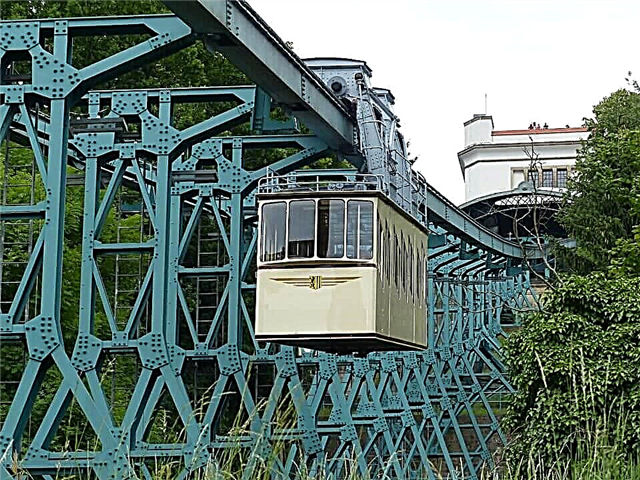
This public transport is worth every tourist taking time to ride. The monorail connects the two districts - Loschwitz and Oberloschwitz. The track is 273 meters long, and the height difference is 84 meters. Passengers cover this distance in 4.5 minutes. The suspension road was built at the very beginning of the 20th century and put into operation in 1901. Two small carriages run along it, the movement of which is distinguished by synchronization.
The monorail went through a turbulent and tragic period in German history and never stopped working. It was not stopped by two world wars, and only in 1984 the cableway was closed for reconstruction, which lasted 8 years. The next renovation was carried out in 2002, when the lower station was redone. From the windows of the carriages a breathtaking view opens up. You can admire the bend of the Elbe, the panorama of the Old Town, appreciate the splendor of the Blue Miracle Bridge.
Transport Museum

Lovers of technology will definitely find time to study the exposition of this museum. It is located in one of the oldest buildings in the city - Johanneum. In the 16th century, the Elector's horses and carriages were kept here. The museum opened its doors for visitors in 1956. Now you can study how the technical idea developed, having familiarized yourself with six sections of the museum - railway transport, an exposition dedicated to cars and motorcycles, trams, air vehicles, water transport and an interesting model of the railway.
The emergence of the museum here is not surprising, because Saxony was once the center of the automotive industry in Germany. The entrance is very impressively decorated - visitors immediately see a racing car, and behind it the wall is decorated with greetings written in many world languages. Tourists can take advantage of the opportunity to photograph the exhibits without restriction.
Dreikenigskirche

The part of the city beyond the Elbe is decorated with the very attractive Church of the Three Wise Men. The high bell tower, built in the neo-baroque style, is the architectural dominant of the area and is visible from afar. The magnificent building adorned the city until February 1945. Then, during the bombing, the nave was completely destroyed, but the bell tower survived. The church stood in ruins for a long time, there was even a project to demolish it, but the parishioners managed to protect it. The recovery lasted for many years and ended only after the country was reunited.
Now you can admire not only the beauty of the building. It is here that a 12-meter long frieze is located - the famous "Dance of Death", created in the 16th century. The altar is also very interesting. After the church was destroyed, it was mothballed and deliberately not restored. The altar serves as a kind of reminder to the descendants of the horrors of war. It clearly shows traces of the fire that raged after the bombing. The bell tower has an observation deck from which you can enjoy a magnificent view of the city.
Albertinum

This building has immortalized in its name the memory of King Albert, who ruled Saxony at the end of the 19th century. It is located at the edge of Brühl's Terrace on the east side. Once there was an arsenal, later the building was rebuilt. Now it houses the Collection of Sculptures, which is adjacent to the Gallery of New Masters. The collection of sculptures presents to visitors the masterpieces created by mankind over five millennia.
There are works of antiquity, magnificent examples of the Renaissance and Baroque periods. Many brilliant creations of our time are presented. The gallery of new masters showcases works created in the era of romanticism and modernity. The Albertinum also played a certain role in the history of our country. It was this collection that inspired Ivan Tsvetaev, after which he created the Museum of Fine Arts in Moscow. Today it is the famous Pushkin Museum of Fine Arts.
House "Music of the Rain"

The city offers its guests an amazing experience not found anywhere else in the world. We are talking about a man-made miracle - the Rain Music house. The amazing five-story building is painted pure blue. The facade of the house is equipped with a complex drainage system. Water flowing down from the roof during the rain passes through many pipes, funnels and drops. This is how beautiful gentle sounds are born that add up to a melody.
Interestingly, the water very similarly imitates the masterful playing of a variety of musical instruments. Many tourists gather here in rainy weather and enjoy the unusual sounds for a long time. The facade of the building gives an impression. The idea for the design came from a group of architects who visited St. Petersburg and were fascinated by the wonderful palaces of this city.
The attraction is located quite far from the historical center, so for a long time it stayed away from the routes proven over the years. But the situation is gradually changing, and more and more travelers come here to enjoy the music of nature performed by the city house.
Augustus the Strong Bridge

You should definitely take a walk along one of the oldest preserved stone bridges in Europe. It connects the Old and New Towns and was built of sandstone. The bridge is not raised, but it has wide enough spans. Vessels easily pass under them, so the structure does not restrict the navigation of the Elbe. In several places on the bridge there are small observation platforms where you can stop and enjoy the magnificent landscape of the river and the Old Town.
Surprisingly, the bridge can be seen on many of the canvases of famous Italian masters. Many of them worked in Dresden, and the majestic structure inspired painters. The bridge is held in high esteem by the locals. Festive processions take place along it. For their implementation, the bridge is closed for traffic. For many centuries, the building has faithfully served people and adorns the urban landscape.
Botanical Garden

This unique collection of plants is part of the Technical University.The botanical garden was founded in the first half of the 19th century, but the destruction of the city at the end of 1945 also affected it. The garden was practically destroyed, but it has come a long way of restoration. For five years, the exhibition was put in order, and in 1950 visitors returned to the garden. Now there are about 10 thousand plants. Among them there are many rare species that are on the verge of extinction.
Plants are divided into geographic sections, each of which represents the most characteristic species in the area. There is also a systematic section. The alpine garden is very beautiful, where you can see many types of alpine plants. Guests can visit large themed greenhouses - aquatic, large tropical, succulent pavilion, American desert plants. The total area of greenhouses reaches 1000 sq. m.
Zoo

The large garden provides not only a place for pleasant walks, but also the opportunity to visit one of the oldest zoos in Germany. In several pavilions there are more than 334 species of animals, represented by about 2,000 individuals. "African House" offers to see elephants, tropical birds, monkeys. An aviary that recreates savannah conditions shows lions. There is a special enclosure for giraffes, where the conditions of detention are as close as possible to real ones.
Of particular interest is the so-called "Professor Brandes" aviary. Here the scientist, who was also the director of the zoo, conducted a famous scientific experiment. He raised a baby orangutan and documented his observations. Now there are not only primates, but also a combed crocodile. The zoo is also an educational center. There is a special scientific school where students can gain extensive additional knowledge.
Pfund Dairy

An amazing building in 1998 was included in the Guinness Book of Records as the most beautiful dairy store. It dates back to 1879. It was then that a peasant named Paul Pfund began supplying the city with milk from his farm. It was this man who first began to produce condensed milk in Germany. Turnover increased and business went so well that it was decided to build a new brand store. And this is not surprising, because by this time the company already owned its own paper and printing factory, smithy, workshops, laundry.
All employees were provided with an apartment and a corporate kindergarten. The store building was built in 1891. It owes its attractive appearance to a beautiful cladding, for which neo-Renaissance ceramic tiles were used. Sketches for her were drawn by Dresden artists. The store survived the harsh years of World War II, but later passed to the state and was eventually closed. For many years the tradition was forgotten, but in the 1990s it resumed its work. Now, as before, you can buy excellent dairy products and attend a cheese tasting.


